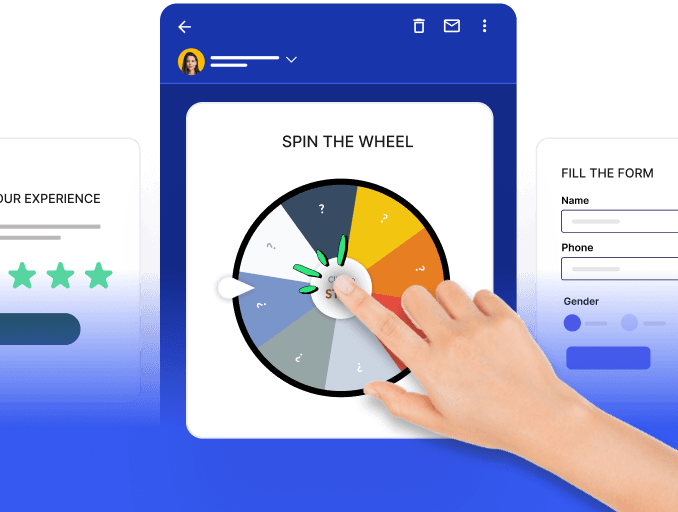Email communication is at the heart of every successful business. Managing emails efficiently and ensuring they reach the intended recipients are paramount. One effective way to achieve this is by utilizing email subdomains. In this article, we'll explore email subdomains and why they are crucial for businesses.
Table of contents
- What is an email subdomain?
- Why use an email subdomain?
- When to use email subdomains?
- How to set up a subdomain?
- 5 Best practices for using email subdomains
- Conclusion
What is an email subdomain?
Email subdomains are subsections of your main domain used specifically for email communication. Simply put, if your domain is "yourbusiness.com," an email subdomain could be "email.yourbusiness.com." What sets them apart from the root domain is that they have their unique IP addresses.
Using subdomains in email addresses provides a simple yet effective way to categorize and manage messages. Using subdomains, organizations can easily differentiate between different departments or functions within their email system.
For instance, imagine you work for a company called Example Inc. If you receive an email from "someone@sales.example.com," you immediately know it pertains to sales-related matters. This helps streamline communication and ensures that messages are directed to the appropriate recipients promptly.
Why use an email subdomain?
Maintaining a positive sender reputation is paramount for email deliverability. A root domain's reputation can be adversely affected if promotional or transactional emails encounter issues. Recovering from a damaged root domain reputation can be challenging. Email subdomains act as a protective shield for your root domain's reputation.
1. Maintain root domains reputation:
When you send emails from a subdomain, you isolate its sender reputation. This means that any issues with one subdomain won't affect the root domain or the other subdomains. In contrast, a shared root domain can be impacted by the performance of all emails sent from it.
2. Reputation recovery is easier:
Should a subdomain encounter deliverability problems, it's easier to address and rectify without harming your root domain's reputation. Recovering from email delivery issues on a root domain is considerably more difficult. Plus if only
3. Categorize different departments:
You can create separate subdomains for different departments of the types of emails you will be sending. It is a great way to organize conversations and manage them effectively.
For example - you wouldn't want your sales emails to get mixed up with your complaints or helpline emails. Neither would you want to mix your transactional emails with your PR emails. It creates confusion and makes it even more difficult to track your efforts in one category.
When to use email subdomains?
Depending on your email communication needs, you can consider setting up multiple subdomains for various purposes. This offers even more granular control.
For example: You can have one subdomain for outreach and PR, one subdomain for transactional emails, etc. This will also help keep your conversations separate from each other and organized.
1. Promotional emails: By assigning a separate subdomain for promotional emails, you can enhance their deliverability. This is especially useful when sending marketing campaigns to a large audience.
2. Outreach and PR: For partnership, outreach, and PR emails, using a different subdomain can be beneficial. It helps distinguish these critical communications from other email types.
3. Transactional emails: Transactional emails, such as order confirmations or password resets, require impeccable deliverability. A dedicated subdomain ensures these emails reach recipients' inboxes consistently. We at Mailmodo use different email subdomains for product sign ups, and lead magnets.
4. Complaint emails: You can also keep a separate email for complaints and give more priority to reply to these promptly. The faster you solve a customer problem, the happier they are.
5. Newsletter: Using a separate subdomain for newsletters makes it easier to track their performance and organize them. You can get precise analytics just for your newsletters, without mixing data from other types of emails.
How to set up a subdomain?
To buy and set up a subdomain and sign up for Mailmodo, follow these steps:
Step 1: Choose a domain registrar
Select a domain registrar where you can purchase and manage your domain and subdomain. Popular registrars include GoDaddy, Namecheap, Google Domains, etc. Visit the registrar's website to get started.
Step 2: Search for and purchase your subdomain
Use the registrar's domain search tool to check if your desired subdomain is available. If it's available, proceed to purchase it. If not, you may need to choose a different subdomain name or consider variations.
Step 3: Set up DNS records for your subdomain
After purchasing the subdomain, you'll need to configure DNS records to point it to the desired IP address or hosting server. This step may vary depending on your registrar, so refer to their documentation or contact with the support team for guidance.
Step 4: Connect it with Mailmodo
Once you've bought your subdomain, you can connect it with your choice of ESP (email service provider). Mailmodo is a great option for this, as it has multiple features to make your email campaigns more effective.
If you need any help setting it up, just book a call) with one of our experts and they will guide you through the process.
5 Best practices for using email subdomains
Now that you understand the significance of email subdomains, it's essential to implement best practices to maximize their effectiveness. Here are some key best practices for using email subdomains:
1. Plan subdomain naming conventions
Establish a clear naming convention for your subdomains. Consider using prefixes like "email," "promo," or "news" to denote the subdomain's purpose. For example, "email.yourbusiness.com" for marketing emails. Don't use different prefixes, it will confuse your team and prospects.
2. Separate subdomains by email type
Create distinct subdomains for different email types. Promotional emails, transactional emails, and outreach emails should each have their dedicated subdomain. This separation helps in maintaining sender reputation and monitoring performance.
3. Consistent authentication setup
Implement email authentication protocols like SPF, DKIM, and DMARC for each subdomain. Consistency in authentication across all subdomains enhances email deliverability and security.
4. Monitor and analyze performance
Regularly monitor the performance of your subdomains. Track metrics such as open rates, click-through rates, bounce rates, and spam complaints. Analyzing these data points allows you to make informed adjustments to your email campaigns.
5. Gradual IP warm-up
If you're using a new subdomain, start with a gradual IP warm-up. Send a small volume of emails initially and gradually increase it. This helps build a positive sender reputation with ISPs. A few tools you can use to warm-up your email subdomain are - Snov.io, Mailshake, etc.
Conclusion
Incorporating email subdomains into your email communication strategy is a wise decision for any business. It not only streamlines email management but also safeguards your sender reputation and ensures consistent email deliverability. Don't underestimate the value of email subdomains in enhancing your business's email communication efficiency and effectiveness.
What you should do next
Hey there, thanks for reading till the end. Here are 3 ways we can help you grow your business:
Talk to an email expert. Need someone to take your email marketing to the next level? Mailmodo’s experts are here for you. Schedule a 30-minute email consultation. Don’t worry, it’s on the house. Book a meet here.
Send emails that bring higher conversions. Mailmodo is an ESP that helps you to create and send app-like interactive emails with forms, carts, calendars, games, and other widgets for higher conversions. Get started for free.
Check out our AI prompts library. If you need AI prompts for ChatGPT or Bing, here's a ready-made database we’ve built to help marketers succeed at prompt engineering. Get your AI prompts here.
Get smarter with our email resources. Explore all our knowledge base here and learn about email marketing, marketing strategies, best practices, growth hacks, case studies, templates, and more. Access guides here.







